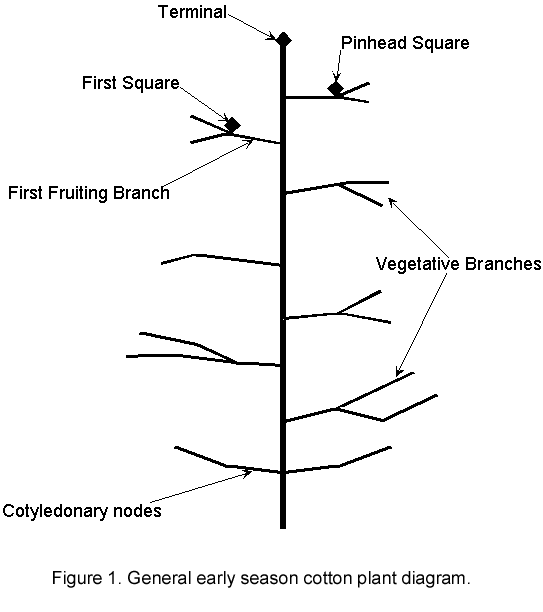The 1999 planting season in Arizona has been full of challenges. Many fields across the state have been replanted, much more so than usual. For example, in some parts of central Arizona, the majority of fields that were planted in March had to be replanted again in April. In general, April was cooler and more windy than normal. Depending on the location in the state, many areas are one to two weeks behind normal in terms of heat unit (HU, 86/55 oF thresholds) accumulations after planting. Accordingly, plant growth and development has been very slow and most fields would be classified as late in relation to the typical stage of growth by early May. The next six to eight weeks are going to be extremely critical in determining the yield potential for most fields.
Important stages in the development of an Arizona cotton crop include the following:
- March/April - planting and stand establishment
- May - plant foundation development
- June - PRIME TIME for fruit formation and retention
According to this outline, the foundation is now being established. This foundation is particularly important with respect to early root system development and the transition from early vegetative growth to reproductive development. It may look like young plants are not growing, however the root systems are expanding at a rapid rate. For example, in an open, well-drained soil profile (free of obstructions or impermeable layers) young cotton plants may exhibit root development as outlined in Table 1. Cooler spring soil temperatures lead to less developed and often damaged root systems, which can also contribute to Rhizoctonia solani (damping off or soreshin) infections. Therefore, when assessing overall crop condition in the early stages of the season, it is very important to monitor general root health and development. The rapid pace of root development early in the season is important in terms of providing part of the foundation upon which the plant will depend as it moves into the fruiting cycle. When the fruiting cycle begins, root development slows down as carbohydrates and mineral nutrients are directed with higher priority towards developing squares and bolls.
There are also several aspects of aboveground early cotton plant development that are important to monitor. Early season plant monitoring is critical for the proper timing and application of some herbicides (e.g. Roundup on Roundup Ready cotton varieties).
Important features to monitor with a young cotton crop include:
- Formation of the first fruiting branch
- Pinhead squares should first appear at nodes 5, 6, or 7 (above
the cotyledonary nodes, which are counted as zero) - refer to Figure
1 (which has the first fruiting branch on node 6).
- This indicates a timely transition from vegetative to reproductive growth.
- If pinhead squares are formed consistently above node 7, this is an early indication of vegetative growth potentials.
- Pinhead squares should first appear at nodes 5, 6, or 7 (above
the cotyledonary nodes, which are counted as zero) - refer to Figure
1 (which has the first fruiting branch on node 6).
- Terminal condition
- If terminals are damaged and lost, forking will occur to form
several mainstem branches.
- This will commonly result in delays of fruiting (approximately two weeks).
- If terminals are damaged and lost, forking will occur to form
several mainstem branches.
- Early fruit retention % (FR%)
- Estimates of FR can be made by counting retained squares and then
dividing by the total number of fruiting sites.
- Prior to first bloom, a good estimate of FR can be made by checking first position squares on all fruiting branches.
- Compare measured FR levels to established AZ baselines (see appropriate
UA Extension bulletins).
- FR should be above about 75% prior to first bloom.
- Estimates of FR can be made by counting retained squares and then
dividing by the total number of fruiting sites.
Proper crop management and monitoring in May establishes the foundation necessary to properly support the bolls set in June. Under the hot and dry weather conditions that are common in June, a cotton crop has the potential to make a strong start on the fruiting cycle and establish a good early boll load. Thus, June (and the period of the fruiting cycle prior to the monsoon season) is referred to as our PRIME TIME. Good crop management in May will provide for a good potential in June, which often is the most efficient production period of the season. Providing adequate irrigation water (avoiding water stress) and controlling insect pests are the most critical management decisions that allow us to realize these early season potentials.
Issued in furtherance of Cooperative Extension work, acts of May 8 and June 30, 1914, in cooperation with the U.S. Department of Agriculture, James A. Christenson, Director Cooperative Extension, College of Agriculture and Life Sciences, The University of Arizona.
The University of Arizona is an equal opportunity, affirmative action institution. The University does not discriminate on the basis of race, color, religion, sex, national origin, age, disability, veteran status, or sexual orientation in its programs and activities.
Any products, services, or organizations that are
mentioned, shown, or indirectly implied in this web document do not imply
endorsement by The University of Arizona.
Information provided by Jeffrey C. Silvertooth, silver@ag.arizona.edu
Extension Agronomist - Cotton, College of Agriculture, The University of Arizona.
Material written 15 May 1999.
Home | Cotton | Advisories
document located at: http://cals.arizona.edu/crops/cotton/comments/may1999cc.html
Copyright © 2001 University of Arizona,
College of Agriculture and Life Sciences
Webmaster: Al Fournier (acis@ag.arizona.edu)

